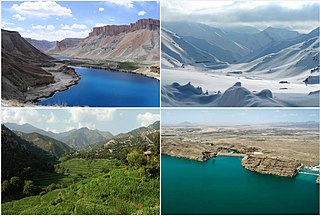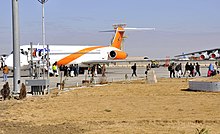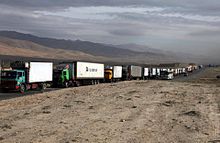
The economy of Afghanistan is listed as 103rd in the world in terms of gross domestic product (GDP) based on purchasing power parity (PPP). With a population of nearly 40 million people, Afghanistan's GDP (PPP) stands at around $77 billion with an exchange rate of $20 billion (2020), and the GDP (PPP) per capita is about $2,000. Its total external debt is 1.4 billion as of 2022. The Afghan economy continues to improve due to the influx of expats, improvement of national infrastructure, establishment of more trade routes with neighboring and regional countries, and expansion of the nation's agriculture and mining sectors.
The Kabul–Kandahar Highway (NH0101) is 483-kilometer (300 mi) long that links Afghanistan's two largest cities, Kabul and Kandahar. It starts from Dashte Barchi in Kabul and passes through Maidan Shar, Saydabad, Ghazni, and Qalat until it reaches Aino Mina in Kandahar. It is currently being rehabilitated at different locations. This highway is a key portion of Afghanistan's national highway system or "National Highway 1". The entire highway between Kabul and Kandahar has no mountain passes but there are many mountains nearby in some places. Approximately 35 percent of Afghanistan's population lives within 50 km (31 mi) of the Kabul to Kandahar portion of the Ring Road.
Pamir Airways was a privately owned airline headquartered in Kabul, Afghanistan, operating scheduled passenger flights out of Kabul International Airport. The company name is derived from the Pamir Mountains and translates "roof of the world".
Bakhtar Afghan Airlines is an airline from Afghanistan, which offers domestic flights. The company was founded in 1967 as Bakhtar Airlines, a name it kept until 1985, when it was renamed Bakhtar Afghan Airlines by Pashtun governments. In 1985 the company absorbed Ariana Afghan Airlines and became Afghanistan's sole airline company. In 1988 the Ariana and Bakhtar brands merged. However, the airline relaunched in 2020.

Herat International Airport, also known as Khwaja Abdullah Ansari International Airport, is located 10.5 km (6.5 mi) southeast of the city of Herat in western Afghanistan, east of the Herat-Farah road, close to Guzara in the Guzara District of the Herat Province. It is Afghanistan's fourth largest commercial airport after the Kabul International Airport in Kabul, the Ahmad Shah Baba International Airport in Kandahar and the Mawlana Jalal ad-Din Muhammad Balkhi International Airport in Mazar-i-Sharif.

Afghanistan International Bank (AIB) is the largest bank in Afghanistan and the only Afghan bank with international transfer to all countries, with its head office in Kabul. The bank has thirty seven branch offices in the major cities of the country. AIB has international shareholders, two Afghan business groups, one Afghan/American business group. It opened in 2004.

Kunduz Airport is located about 5 miles (8.0 km) southeast of Kunduz, the capital of Kunduz Province in Afghanistan. It is a domestic airport under the country's Ministry of Transport and Civil Aviation (MoTCA), and serves the population of Kunduz Province. Security in and around the airport is provided by the Afghan National Security Forces.

Jalalabad Airport, also known as Nangarhar Airport, is located next to the Kabul–Jalalabad Road, about 3 miles (4.8 km) southeast of Jalalabad, which is the capital of Nangarhar Province in Afghanistan. It is a domestic airport under the country's Ministry of Transport and Civil Aviation (MoTCA), and serves the population of not only Nangarhar but also neighboring Kunar, Nuristan and Laghman provinces. It is also used by the Ministry of Defense for military purposes. Security in and around the airport is provided by the Afghan National Security Forces.
Khost Airport, also known as Khost International Airport, is located in the eastern section of Khost, which is the capital of Khost Province in Afghanistan. It is under the country's Ministry of Transport and Civil Aviation (MoTCA), and is used for domestic and international flights. The Ministry of Defense also uses it for emergency relief purposes such when the recent earthquake occurred in the area.

Afghanistan has three railway lines in the north of the country. The first is between Mazar-i-Sharif and the border town of Hairatan in Balkh province, which then connects with Uzbek Railways of Uzbekistan. The second links Torghundi in Herat province with Turkmen Railways of Turkmenistan. The third is between Turkmenistan and Aqina in Faryab province of Afghanistan, which extends south to the city of Andkhoy. The country currently lacks a passenger rail service, but a new rail link from Herat to Khaf in Iran for both cargo and passengers was recently completed. Passenger service is also proposed in Hairatan – Mazar-i-Sharif section and Mazar-i-Sharif – Aqina section.

National Highway 01 or NH01, formally called the Ring Road, is a 2,200 kilometres (1,400 mi) two-lane road network circulating inside Afghanistan, connecting the following major cities (clockwise): Kabul, Maidan Shar, Ghazni, Kandahar, Delaram, Herat, Maymana, Sheberghan, Mazar-i-Sharif, Puli Khumri and back to Kabul. It has extensions that connect Jalalabad, Bamyan, Khost, Lashkargah, Zaranj, Farah, Islam Qala, Torghundi, and Kunduz. It is part of AH1, the longest route of the Asian Highway Network. National Highway 01 consists of four major sections, NH0101 to NH0104, linking the major economic centers.

Energy in Afghanistan is provided by hydropower followed by fossil fuel and solar power. Currently, less than 50% of Afghanistan's population has access to electricity. This covers the major cities in the country. Many rural areas do not have access to adequate electricity but this should change after the major CASA-1000 project is completed.

Tourism in Afghanistan is regulated by the Ministry of Information and Culture. There are at least 350 tourism companies operating in Afghanistan. Tourism was at its peak before the 1978 Saur Revolution, which was followed by the decades of war. Between 2013 and 2016, Afghan embassies issued between 15,000 and 20,000 tourist visas annually.

The COVID-19 pandemic in Afghanistan is part of the worldwide pandemic of coronavirus disease 2019 caused by severe acute respiratory syndrome coronavirus 2. The virus was confirmed to have spread to Afghanistan when its index case, in Herat, was confirmed on 24 February 2020.
This article documents the timeline of the COVID-19 pandemic in Afghanistan.
2021 (MMXXI) was a common year starting on Friday of the Gregorian calendar, the 2021st year of the Common Era (CE) and Anno Domini (AD) designations, the 21st year of the 3rd millennium and the 21st century, and the 2nd year of the 2020s decade.

The Battle of Kandahar began on 9 July 2021, as Taliban insurgents assaulted the city to capture it from the Afghan National Security Forces (ANSF). After heavy fighting for weeks the city's defenses had started to dissolve in August. This allowed the Taliban to enter and overrun most of the city on 12 August 2021, including the Sarposa prison, which included the release of over 1,000 prisoners, and ultimately the capture of the city. However, the siege for the nearby airport continued, where government loyalists held out until being evacuated on 16 August.






















